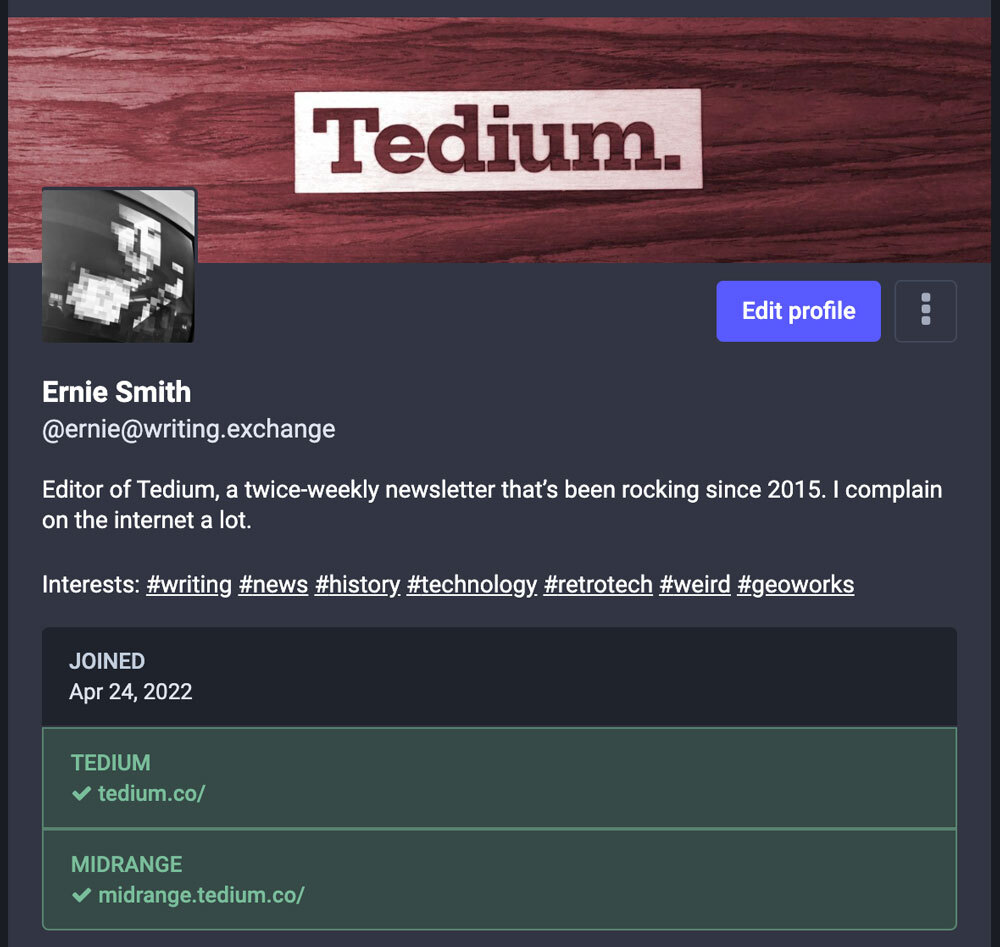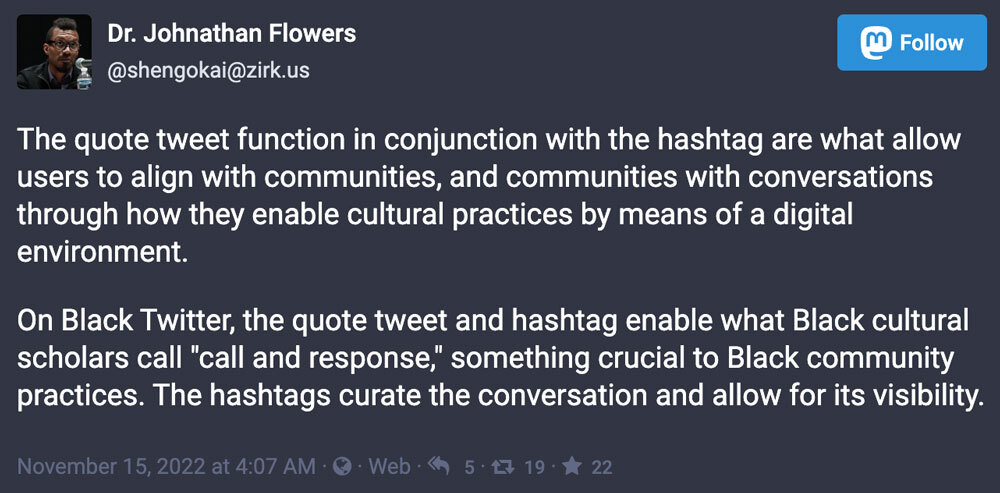
Don’t want two horns? Don’t need two horns. (casmium/Flickr)
Hey all, here’s yet another issue of the Mastodon pop-up. We have just two issues left of this whole thing, so we’re trying to make them count.
Speaking of making things count, yesterday was the big release of Mastodon 4, a significant upgrade for the software that adds a bunch of new features, including a handful of things that Twitter has long had (the ability to translate posts in the feed) along with some things it has never had (the ability to filter a follower’s post by language).
But the nice thing about upgrades like these in Mastodon is that they’re not prescriptive for the most part—they instead represent suggestions. And that makes all the difference.
New Horizons for Social Media

You have the room to change this technology
Yesterday, I talked about the idea of the “Infernal September,” the idea that Mastodon in particular and the fediverse in general were facing a trial by fire, and how that would affect the culture.
I’d like to flip that to some degree and make the case that there are likely cases where new perspectives can help positive reshape the approaches to decision-making that has already taken hold. Or, that those existing perspectives can be ignored entirely.
Part of the reason certain cultural norms have taken hold on Mastodon is because the users got there first helped to define the original shape of the technology. Those users, often from marginalized communities, wanted certain things out of their experiences, and that meant that they could influence the program as well as the design of the servers.
With open-source software, the commons are king, and I think that this kind of influence is a relatively new feeling in social media. See, social media has in the past worked where features were essentially foisted onto you, with no ability to turn them down if you did not want them.
Famously, Facebook’s many redesigns over the years are a great example of this in action. The News Feed, one of its most iconic features, was a hugely controversial change at first because of the way it changed the experience for end users. It raised privacy concerns. That might seem old school now, but I think with some retrospect, some might argue that while a fundamental feature of Facebook today, the News Feed ended up being a harbinger for things to come.
Later redesigns also proved controversial, but users were not in a place to resist them because ultimately they were working within someone’s walled garden, and the old design didn’t meet some financial target.

Outside of the walled garden, you have more choices. (Xavi Cabrera/Unsplash)
With open-source software, there is flexibility to have some say over how the software gets used, and what gets added. A good example of what I mean here can actually be seen in version 4 of Mastodon. Because of the added importance of hashtags on Mastodon, the service now makes it possible to follow hashtags in the way you might follow individual users. Also, it is now possible to edit posts, no additional handwringing or gating or long debates about it in the public square. It’s just there.
But on the other hand, if you run a server, there may be some things you might not want. Maybe you don’t want your users to edit their posts, so you disable that. (They can go elsewhere if they need that feature.) Maybe you hate Twitter’s trending topics feature and you don’t want an equivalent on your server. If you’re the admin, you can turn it off; if you’re not, you can make the case to the admin. And if you don’t like the decisions of the server admin, you can start your own server.
This is not a new phenomenon. A famous example from the world of Linux: In 2011, an upgrade to the desktop environment GNOME proved so controversial among many end users that some users made the decision to fork the old version of the project and continue to use it. That fork, called MATE, is still active today.
In a world of open-source social media software, as long as it can plug into the main thing (that being the Fediverse), end users still have plenty of choice. That choice can shape the project or it can simply shape your instance.
The fact is, though, we have it. And that means you can embrace or ignore it as much as you’d like.
Tips & Tricks

I got the checkmarks on my profile because I include a link to my Mastodon profile on my websites.
Wanna get verified? It’s as easy as putting a special link on your website
You likely heard about the mess that Twitter ran into last week after it tried changing up the way it managed its verification.
And you may wonder, given how broken verification is on Twitter, how Mastodon could make verification work on their side of the coin, and the answer is … quite easily, actually. If you own a specific website or have some notable thing closely associated with you (like I have this newsletter), if you add a link to your Mastodon profile with the addition of the rel=“me” tag to the anchor, you offer Mastodon two sides of verification that can prove your identity.
Sure, that’s not as in-depth as, say, showing a primary source your ID card. But it can go a long way to help tie you to existing identity on the internet, which is what verification is really all about.
If that doesn’t seem like enough, the Mastodon project offers this suggestion in its docs: “Because Mastodon can be self-hosted, there is no better way to verify your identity than to host Mastodon on your own domain, which people already trust.”
And if you want a more in-depth verification process that accounts for more in-depth security considerations, there is an option for that as well, in the form of Keyoxide, which verifies users through cryptography across a variety of platforms. At this time, it requires some technical knowledge to use, but it is even more foolproof if your goal is to prove you are who you are.
(If your goal is to win a special prize for notability, you won’t find that here.)
Links & Stuff
» Trying to wrap your head around Mastodon’s content moderation approach? You might find value in this academic paper, written by Alan Z. Sozenshtein of the University of Minnesota Law School, which makes the case that federation can be a strong control.
» Who said Mastodon instances couldn’t be high-concept? The instance Brands.town has found interest as a collection of accounts parodying various brands, such as Google, Spotify, and Duolingo. I wouldn’t trust the verification here.
» The Internet Archive has hit Mastodon, with founder Brewster Kahle making the case in a blog post against centralized social media. “We need a game with many winners,” he said.
One Killer Take

Dr. Johnathan Flowers, an assistant professor of philosophy at California State University Northridge, arguing in favor of the quote tweet on his Mastodon account, based on the communication styles of Black Twitter in particular. The entire thread is a useful way to understand critiques that marginalized communities have had about lacking features in Mastodon.
Alright, that’s it for issue five of How To Mastodon, a pop-up newsletter hiding inside of MidRange. Follow me on Mastodon for more insights and tips, along with all the other weird stuff I’m interested in. Be sure to check out the final issue tomorrow for more!



